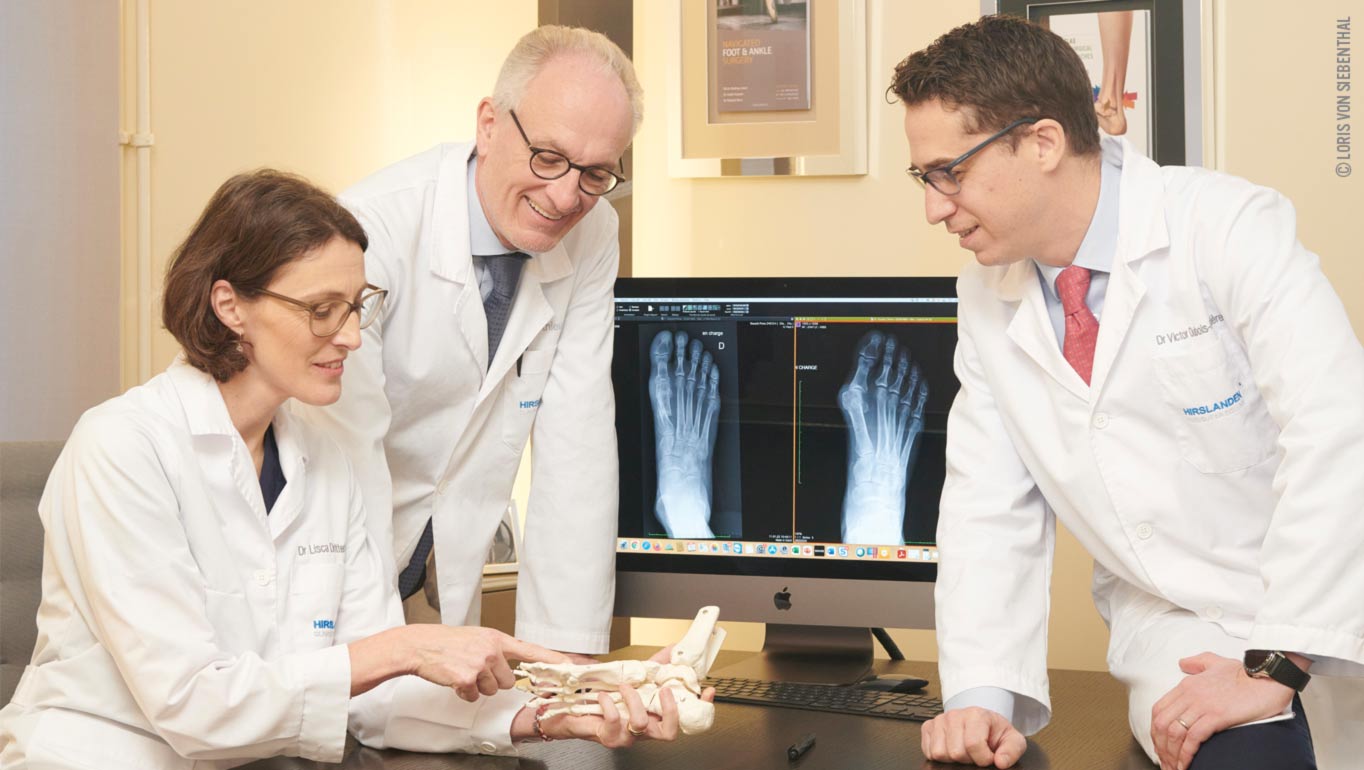Dr. Lisca Drittenbass, Foot and Ankle Surgeon at the Centre ASSAL for Foot & Ankle Surgery at Hirslanden Clinique La Colline in Geneva, answers questions about this condition.
What exactly is a hallux valgus deformity?
The visible bump commonly called a bunion is not actually an additional bony growth, but the head of metatarsal bone which has deviated towards the inside of the foot. To compensate for this bad alignment, the big toe, the ‘hallux’, in turn deviates towards the second toe, creating the so-called ‘valgus’ position.
Do narrow or high-heeled shoes cause hallux valgus?
There is no need to feel guilty about your high heels: the underlying cause for a hallux valgus is a genetic predisposition, which happens to be much more common in women than in men. However, with this predisposition once the bunion has started forming, ill-fitting shoes can become an accelerating factor.
What problems can hallux valgus cause?
Aside from aesthetic considerations, hallux valgus can cause discomfort and pain around the bump. Pressure or constant friction often cause redness and recurrent swelling. With time, the forefoot deformity can also lead to pain at the second metatarsal. To alleviate pressure off the painful first toe, the load of the bodyweight is often transferred to the adjacent rays and which in turn causes painful inflammation of the second metatarsal and toe, a phenomenon called ‘transfer metatarsalgia’. This chronic overload can also lead to inflammation of the plantar plate, a ligamentous structure underneath the toe responsible for keeping it straight. With time, the plantar plate can tear and lead to a hammer toe. This is why in an advanced stage of hallux valgus the toes sometimes cross over each other.
I have a hallux valgus. What do I need to do?
The presence of hallux valgus does not require any particular treatment if it is not painful. While adapted shoes with enough space for the toes to align comfortably are preferred if mild symptoms occur, wearing elegant, even high-heeled shoes is still allowed if they do not cause pain. Pain on the second metatarsal can be remedied with an orthopedic insole which helps to restore correct weight distribution.
Can splints or exercises correct hallux valgus?
Orthotics and night splints cannot correct the deformity, they are uncomfortable and unnecessary. Training of the foot muscles by specific exercises can increase stability and may help against further deformation, but cannot correct an existing deformity either.
How do I know if my hallux valgus needs surgery?
Surgery should generally be considered if symptoms like pain or second toe deformation occur and conservative treatment fails to provide sufficient relief. At what moment this point is reached is ultimately a very personal decision and depends on lifestyle, activity level and individual expectations. It is best to seek the advice of an experienced foot and ankle surgeon. Nowadays, even very severe hallux valgus deformities can be treated by an experienced foot and ankle surgeon with very good results. It is therefore never too late to inquire about possible treatment.
What is the best surgical technique?
Various surgical techniques exist. Depending on the degree and type of the present deformity, your foot and ankle surgeon will define the appropriate treatment for your particular condition. This is essential for a good and lasting result, as each case of hallux valgus is unique and requires an ‘à la carte’ solution. What all techniques have in common is that they aim to restore the alignment and stability of the first ray, achieved by cutting and realigning the bone. In cases with mild deformity, the correction of the hallux valgus can be performed via a minimally invasive percutaneous technique to preserve the tissue envelope around the foot.
Does hallux valgus surgery require general anesthesia?
Surgery only requires regional anesthesia, meaning only the foot and sometimes the leg need to be numbed. Depending on the patient’s wish, additional sedation can be added for the 30-60 mins the procedure usually lasts.
Is the surgery painful?
Thanks to local anesthetic injections, pain after surgery is very well controlled. Remaining discomfort can easily be handled with non-opioid painkillers and by elevation and cooling of the operated foot.
How long does it take to recover from hallux valgus surgery?
About three to four months, which corresponds to the time bone needs to heal. This is true whether a percutaneous or an open approach has been applied. After surgery a special stiff-soled shoe or, in rare cases, a cast, is required for six weeks. The foot is expected to remain a bit swollen during the whole recovery period; wearing a comfortable running shoe is recommended during this time. Tight fitting and dress shoes can usually be worn after four months.



